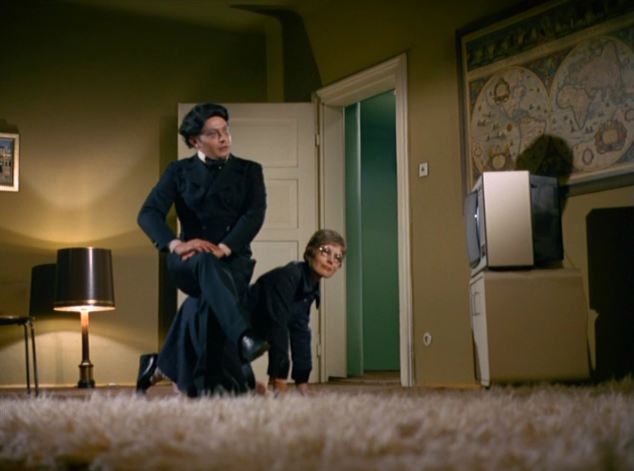When push comes to shove and Walter Kranz needs more money in Fassbinder's Satansbraten, he calls one of his fans, a woman called Andrée who has been writing to him for years. Andrée is the ultimate horror role for any Fassbinder actress; unattractive, vacillating and there to be abused, and Kranz is deeply excited at the possibility of another woman to prey upon, being the niggardly and selfish swine he is. It is even funny that Fassbinder spared Irm Hermann here and gave the part to Margit Carstensen, who only ever played beautiful people in all Fassbinder films.
In Satansbraten we don’t just get critique of the cult of the artist, and of artistic creation, but something more valuable and mordantly fitting – critique of the art lovers. It is after all the art lovers’ job to keep these massive egos that they follow in their business.
When Andrée arrives with her pitiful spectacles and pitiful selection of belongings, Kranz has already started dressing like Stefan George. He is both attracted and appalled by this woman who prays each morning for an hour, in front of his photo. He might admit to liking that idea as well although he obviously finds it below contempt, but Margit Carstensen as Andrée also believes in God, which is of course a threat. It’s all guaranteed to disgust the already fragile Kranz, although he is clear what he needs from this encounter – money – and he is so disappointed that Andrée doesn’t turn up with any. However, everyone has their uses in life, as we see later.
None of this was anything approaching the type of comedy that I think Carstensen was used to, certainly on film, and it seems to be both a strain and a refreshing change for her. The thing is, Carstensen is funny and glamorous in Mother Kusters Goes to Heaven, but that is because of her stillness and her creepy smile; Satansbraten is for Margit Carstensen, the greatest journey into Guignol, certainly in Fassbinder, and also of its era.
Because she is an outsider, Andrée must be punished; and her punishment is that she must join the Kranz household. She is happy to be near the man she worships, although when she has egg spat over her by Volker Spengler, it’s still a shock – almost as if the comedy has been too gentle up until this point. This is Satansbraten after all, and it is extreme, and to the point. Like Kranz’s other female fans, Andrée has no problem with the fact that from time to time she must be punished for no discernible reason; and in this state of reverence and self-abnegation she is happy to undergo the most ridiculous tortures – such as being locked in the cellar.
And it’s not just that. We are well aware that the brother Ernst is creepy, simple, perverted, sexually unfit, and probably even murderous, and Kranz is happy to send in Ernst to do with her as he will – which stands for nothing more than the most outrageous and criminal assault and punishment, for nothing more than naivety, which in the case of artistic admiration, is certainly a crime that Fassbinder thinks merits punishment. Once raped, Andrée the virgin book lover becomes mad, but it appears that she can handle this because it is what she possesses bourgeois asceticism, the most noble thing there is.
The rape, Andrée agrees, turns her into a whore – making her equivalent to so many others in the film. Kranz at the start of the film, is himself feeling like an unpaid whore. Andrée agrees to more and more indignity because as Kranz says, she is one of the weak ones, and it appears there are so many. The highlight of this – and it is highlighted once more by the film’s sinister music – is the instruction: ‘form a bridge’ – which Carstensen gladly does for Kranz/George to sit upon. The bridge is in and of itself, according to Kranz, a documentation of truth. It is my supreme aspiration, says Andrée , to be used by a strong man — and it is an image Fassbinder had already used in his antiteater work. She also has a sister called Elvira (see In a Year of Thirteen Moons), an impertinent, ignorant, arrogant sister — but make of that what you will.
The worst moment for this stupid cow, as she styles herself, is when she sees the mighty Kranz/George smiling after he’s been beaten, at which juncture she realises that Kranz is just as weak and masochistic as she is – or rather, that she has ignore this fact in favour of popping him on the artistic pedestal. Incredibly, of all the characters in this daft film, the one played by Margit Carstensen is the only one that grows up and moves on, a better person.
Acts of physical and verbal aggression are the bread and butter of Satan’s Brew; so it is right that Andrée rejects Kranz after Kranz has been beaten up and admits that he enjoyed it; it is a sign that her character believes that the greatest pleasure in life (as a weakling) is to be used by the strong — a joke both about Nazism and about the director himself. Fassbinder often liked to confuse the two, and would at any point, and wherever he could, make jokes about Hitler. He didn't believe that Hitler could ever be ridiculed enough, and we have to remember too, that it was Hitler also, who fancied hismelf as an artist.



